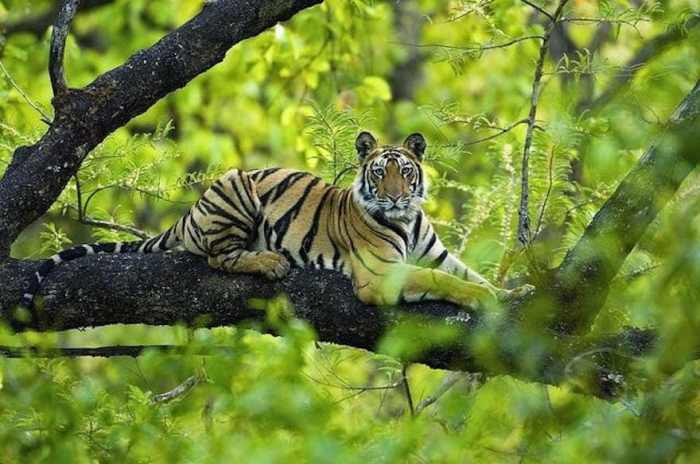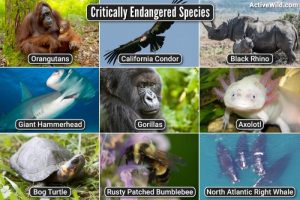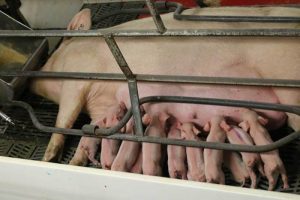
Embark on a journey through the world of Wildlife conservation efforts, where each action taken plays a vital role in preserving our planet’s rich biodiversity and ensuring a sustainable future for all living beings.
From the crucial importance of conservation to the innovative strategies employed, this topic sheds light on the intricate balance between human activities and wildlife preservation.
Overview of Wildlife Conservation Efforts
Wildlife conservation efforts play a crucial role in preserving the planet’s biodiversity and ensuring the survival of various species. The protection of wildlife habitats and ecosystems is essential for maintaining a healthy environment for all living organisms.
Importance of Wildlife Conservation
Wildlife conservation is important because it helps in safeguarding endangered species from extinction and preserving the delicate balance of ecosystems. By protecting wildlife, we also protect natural resources and ensure a sustainable future for generations to come.
Role of Wildlife Conservation in Maintaining Ecological Balance
Wildlife conservation helps in maintaining the ecological balance by preserving the natural habitats of various species. Each organism plays a specific role in the ecosystem, and the loss of one species can have a ripple effect on the entire ecosystem. By protecting wildlife, we ensure a harmonious coexistence of all living organisms.
Impact of Human Activities on Wildlife and the Need for Conservation Efforts
Human activities such as deforestation, pollution, poaching, and habitat destruction have a detrimental impact on wildlife populations. Conservation efforts are necessary to mitigate these threats and protect vulnerable species from extinction. It is our responsibility to preserve wildlife and ensure a sustainable future for all living beings.
Conservation Strategies

Conservation strategies play a crucial role in protecting wildlife and preserving biodiversity. By implementing various approaches, we can work towards ensuring the survival of endangered species and maintaining the delicate balance of ecosystems.Protected areas, such as national parks and wildlife reserves, are essential for safeguarding habitats and providing a safe haven for wildlife. These areas restrict human activities that may harm the environment and serve as critical breeding grounds for endangered species.
Habitat Preservation
Preserving natural habitats is one of the most effective conservation strategies. By protecting forests, wetlands, and other ecosystems, we can ensure that wildlife has access to food, shelter, and breeding grounds. Habitat preservation also helps to maintain biodiversity and prevent species extinction.
- Establishing protected areas to safeguard crucial habitats
- Restoring degraded ecosystems to create suitable environments for wildlife
- Implementing sustainable land-use practices to minimize habitat destruction
Captive Breeding
Captive breeding programs are designed to breed and raise endangered species in controlled environments, such as zoos or breeding centers. These programs help to increase the population of threatened species and prevent their extinction.
- Pairing genetically diverse individuals to promote healthy offspring
- Reintroducing captive-bred animals into the wild to boost wild populations
- Monitoring and managing breeding programs to maintain genetic diversity
Anti-Poaching Measures
Poaching poses a significant threat to wildlife populations, especially for species targeted for their valuable parts, such as ivory or horns. Anti-poaching measures are essential to combat illegal hunting and protect endangered species.
- Training and deploying anti-poaching patrols in vulnerable areas
- Implementing stricter penalties for poachers and wildlife traffickers
- Engaging local communities in conservation efforts to reduce poaching activities
Success Stories in Wildlife Conservation
In the realm of wildlife conservation, there have been numerous success stories that showcase the positive impact of dedicated efforts towards protecting endangered species. These projects not only highlight the resilience of nature but also emphasize the importance of conservation strategies in preserving biodiversity for future generations.
Reintroduction of California Condors
The California Condor, once on the verge of extinction with only 27 individuals left in the wild, has made a remarkable comeback thanks to conservation initiatives. Through captive breeding programs and habitat protection, the population of these majestic birds has increased to over 400 individuals today. This success story underscores the effectiveness of collaborative efforts in saving a critically endangered species from the brink of extinction.
Community-Led Sea Turtle Conservation
In many coastal communities around the world, local residents have played a crucial role in the conservation of sea turtles. By actively participating in nest protection, monitoring programs, and beach clean-ups, these communities have contributed significantly to the recovery of sea turtle populations. Their involvement not only benefits the marine ecosystem but also fosters a sense of stewardship and responsibility towards wildlife conservation.
Revival of Giant Panda Population
The conservation efforts directed towards the iconic Giant Panda in China have resulted in a significant increase in their population numbers. With strict protection measures, reforestation projects, and habitat restoration, the Giant Panda population has rebounded, shifting their status from endangered to vulnerable. This success story demonstrates the positive outcomes that can be achieved through long-term conservation strategies and dedicated conservationists.
Technology and Innovation in Wildlife Conservation
In recent years, technology and innovation have played a crucial role in wildlife conservation efforts, revolutionizing the way we protect and monitor endangered species.
GPS Tracking, Drones, and Camera Traps
- GPS tracking devices have enabled researchers to monitor the movement patterns of animals in real-time, allowing for more effective conservation strategies.
- Drones are being used to conduct aerial surveys, track wildlife populations, and monitor poaching activities from a safe distance.
- Camera traps have provided valuable insights into the behavior of elusive species, helping conservationists better understand their habitat requirements.
Genetic Research and Biotechnology
- Genetic research plays a key role in wildlife conservation by identifying genetic diversity within populations and guiding breeding programs to avoid inbreeding.
- Biotechnology techniques such as in vitro fertilization and embryo transfer have been used to assist in the reproduction of endangered species with low reproductive rates.
- Genetic technologies are also helping to combat wildlife diseases and develop strategies for reintroducing species back into their natural habitats.
Artificial Insemination and Assisted Reproductive Techniques
- Artificial insemination has been successfully used in species with reproductive challenges, such as giant pandas and rhinos, to increase breeding success rates.
- Assisted reproductive techniques like ovum pick-up and sperm cryopreservation are providing new hope for critically endangered species on the brink of extinction.
- These innovative approaches are essential tools in the conservation toolbox, offering a lifeline for species facing threats such as habitat loss and climate change.
Wildlife Conservation and Local Communities
Engaging local communities in wildlife conservation efforts is crucial for the long-term success of preserving biodiversity and protecting endangered species. Local communities often live in close proximity to wildlife habitats and can play a significant role in conservation efforts.
The Importance of Engaging Local Communities
- Local communities have valuable traditional knowledge about wildlife and ecosystems, which can be instrumental in conservation efforts.
- By involving local communities, conservation projects are more likely to be sustainable and effective in the long run.
- Empowering local communities to participate in conservation activities can also lead to greater awareness and appreciation for wildlife and the environment.
Benefits of Ecotourism and Sustainable Livelihood Projects
- Ecotourism can provide economic incentives for local communities to protect wildlife habitats and promote conservation awareness.
- Sustainable livelihood projects, such as beekeeping or handicrafts, can offer alternative income sources that reduce reliance on activities harmful to wildlife.
- These initiatives not only benefit local communities economically but also foster a sense of stewardship towards wildlife and their habitats.
Role of Education and Outreach Programs
- Education and outreach programs can help build community support for wildlife conservation by raising awareness about the importance of biodiversity and the threats facing wildlife.
- Engaging schools, local leaders, and community members in conservation education can instill a sense of responsibility and encourage sustainable practices.
- By fostering a culture of conservation within local communities, we can create a collective effort towards protecting wildlife for future generations.
Animals, Livestock, and Wildlife Conservation

In the realm of wildlife conservation efforts, it is important to differentiate between domestic animals, known as livestock, and wild animals. While both play a significant role in ecosystems, they have different impacts and considerations when it comes to conservation.
Livestock vs. Wild Animals
Livestock refers to domesticated animals such as cows, sheep, and goats, which are raised for agricultural purposes. On the other hand, wild animals are those that exist in their natural habitats and play a crucial role in maintaining ecosystem balance.
- Livestock grazing can have a direct impact on wildlife habitats by degrading vegetation, leading to habitat loss for native species.
- Overgrazing by livestock can also contribute to soil erosion, reducing the overall quality of the habitat for wildlife.
- Competition for resources such as water and food between livestock and wildlife can further exacerbate the challenges faced by wild animals in their natural environments.
Balancing the needs of livestock farmers and wildlife conservationists is essential for sustainable coexistence and ensuring the protection of biodiversity.
Balancing Livestock Farming and Wildlife Conservation
Livestock farming is a vital source of livelihood for many communities, but it is crucial to implement sustainable practices that minimize negative impacts on wildlife.
- Implementing rotational grazing techniques can help prevent overgrazing and allow vegetation to recover, benefiting both livestock and wildlife.
- Establishing wildlife corridors and protected areas can help mitigate the effects of livestock grazing on sensitive habitats and provide safe passage for wildlife.
- Promoting sustainable land management practices and providing incentives for conservation efforts can encourage collaboration between livestock farmers and conservationists.
Last Recap
As we wrap up our exploration of Wildlife conservation efforts, it becomes evident that our collective efforts today will shape the thriving ecosystems of tomorrow, underscoring the profound impact each individual can make in safeguarding our precious wildlife.
FAQs
How do conservation strategies help protect wildlife?
Conservation strategies like habitat preservation and anti-poaching measures create safe spaces for wildlife to thrive without human interference.
What role do local communities play in wildlife conservation?
Local communities are crucial in conservation efforts as their involvement ensures sustainable practices and fosters a sense of responsibility towards wildlife protection.
How does technology contribute to wildlife conservation?
Technology aids conservation through tools like GPS tracking and drones, enabling researchers to monitor wildlife populations and protect them from various threats.





